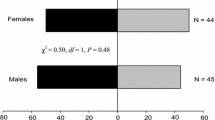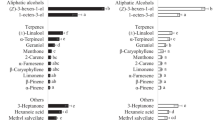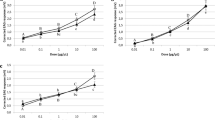Abstract
The responses ofCeutorhynchus assimilis Payk. (Coleoptera, Curculionidae) to the odor of overwintered and new generation weevils were studied using an olfactometer, choice tests in a laboratory cage, field tests using sticky traps baited with live weevils, and by electroantennograms (EAG's). Unmated male weevils and, to a lesser extent, female weevils of the overwintered generation were attracted to the odor of live unmated over-wintered female weevils. New generation weevils exhibited no behavioral response to conspecific odor. Male and female weevils of the overwintered generation exhibited positive EAGs to hexane extracts of overwintered female weevils, whereas EAGs of new-generation weevils of either sex were unresponsive to these extracts. This suggests that the unmated female weevils from the overwintered generation produce a volatile chemical or chemicals that attracts unmated male and female weevils. The new generation of female weevils does not produce this attractive chemical before overwintering, and male and female weevils of this generation can not detect the chemical(s) via their antennal chemoreceptors until they have undergone their overwintering period.
Similar content being viewed by others
References
Blight, M.M., andWadhams, L.J. 1987. Male-produced aggregation pheromone in pea and bean weevil,Sitona lineatus (L.).J. Chem. Ecol. 13:733–739.
Blight, M.M., Pickett, J.A., Wadhams, L.J., andWoodcock, C.M. 1989. Antennal responses ofCeutorhynchus assimilis andPsylloides chrysocephala to volatiles from oilseed rape. Production and protection of oilseed rape and otherBrassica crops.Aspects Appl. Biol. 23:329–334.
Dethier, V.G., Barton-Browne, L., andSmith, C.N. 1960. The designation of chemicals in terms of the responses they elicit from insects.J. Econ. Entomol. 53:134–136.
Dickens, J.C. 1984. Olfaction in the boll weevil,Anthonomus grandis Boh. (Coleoptera: Curculionidae): Electroantennogram studies.J. Chem. Ecol. 10:1059–1085.
Dmoch, J. 1965. The dynamics of a population of the cabbage seedpod weevil (Ceuthorrhynchus assimilis Payk.) and the development of winter rape. Part II.Ekol. Pol. Ser. A. 8:464–469.
Evans, K.A. 1991. The role of secondary plant metabolites in host-plant location by insect pests of oilseed rape,Brassica napus L. PhD thesis. Hatfield Polytechnic, England.
Evans, K.A., andAllen-Williams, L.J. 1989. The response of the cabbage seed weevil (Ceutorhynchus assimilis Payk.) and the brassica pod midge (Dasineura brassicae Winn.) to flower colour and volatiles of oilseed rape. Production and protection of oilseed rape and otherBrassica crops.Aspects Appl. Biol. 23:347–354.
Evans, K.A., andAllen-Williams, L.J. 1992. Electroantennogram responses of the cabbage seed weevil,Ceutorhynchus assimilis, to oilseed rape,Brassica napus ssp.oleifera, volatiles.J. Chem. Ecol. 18:1641–1659.
Evans, K.A., andAllen-Williams, L.J. 1993. Distant olfactory response of the cabbage seed weevil,Ceutorhynchus assimilis, to oilseed rape odour in the field.Physiol. Entomol. 18:251–256.
Ferguson, A.W., andWilliams, I.H. 1991. Deposition and longevity of oviposition-deterring pheromone in the cabbage seed weevil.Physiol. Entomol. 16:27–33.
Guerin, P.M., andVisser, J.H. 1980. Electroantennogram responses of the carrot fly,Psila rosae, to volatile plant components.Physiol. Entomol. 5:11–119.
Kozlowski, M.W. 1984. Selective responsiveness of the antennal olfactory system in the cabbage seed weevil,Ceutorhyncus assimilis towards host plant volatiles.Acta Physiol. Pol. 35:577–579.
Kozlowski, M.W., Lux, S., andDmoch, J. 1983. Oviposition behaviour and pod marking in the cabbage seed weevil,Ceuthorhyncus assimilis.Entomol. Exp. Appl. 34:277–282.
Lamb, R.J. 1989. Entomology of oilseedBrassica crops.Annu. Rev. Entomol. 34:211–229.
Mason, L.J., Jansson, R.K., andHeath, R.R. 1990. Sampling range of male sweetpotato weevils (Cylas formicarius elegantulus) (Summers) (Coleoptera: Curculionidae) to pheromone traps: Influence of pheromone dosage and lure age.J. Chem. Ecol. 16:2493–2502.
Mustaparta, H. 1975. Responses of single olfactory cells in the pine weevil,Hylobius abietis L. (Coleoptera: Curculionidae).J. Comp. Physiol. 97:271–290.
Ni, X., McCaffrey, J.P., Stolz, R.L., andHarmon, B.L. 1990. Effects of postdiapause adult diet and temperature on oogenesis of the cabbage seedpod weevil (Coleoptera: Curculionidae).J. Econ. Entomol. 83:2246–2251.
Nielsen, B.S., andJensen, T.S. 1993. Spring dispersal ofSitona lineatus—the use of aggregation pheromone traps for monitoring.Entomol. Exp. Appl. 66:21–30.
Rochat, D., Malosse, C., Lettere, M., Ducrot, P.H., Zagatti, P., Renou, M., andDescoins, C. 1991. Male-produced aggregation pheromone of the American palm weevil,Rhynchophorus palmarum (L.), (Coleoptera. Curculionidae): Collection, identification, electrophysiological activity and laboratory bioassay.J. Chem. Ecol. 17:2127–2141.
Rochat, D., Descoins, C., Malosse, C., Nagnan, P., Zagatti, P., Akamou, F., andMariau, D. 1993. Chemical ecology of Palm weevils,Rhynochophorus spp. (Coleoptera).Oléagineux 48:225–236.
Roseland, C.R., Bates, M.B., andOseto, C.Y. 1990. Role of a male-produced pheromone of the red sunflower seed weevil (Coleoptera: Curculionidae) in host finding.Environ. Entomol. 19:1675–1680.
Sokal, R.R., andRohlf, F.J. 1981. Biometry. The Principles and Practice of Statistics in Biological Research, 2nd ed. Freeman, San Francisco.
Trung, V.Q., Karan Singh, andMajmuder, S.K. 1988. Behavioural response of rice weevil,Sitophilus oryzae (L.), to male and female produced chemicals.Indian J. Exp. Biol. 26:1000–1002.
Vet, L.E.M., van Lenteren, J.C., Heymans, M., andMeelis, E. 1983. An airflow olfactometer for measuring olfactory responses of hymenopterous parasitoids and other small insects.Physiol. Entomol. 8:97–106.
Weissling, T.J., Giblin-Davis, R.M., andScheffrahn, R.H. 1993. Laboratory and field evidence for male-produced aggregation pheromone inRhynchophorus cruentatus (F.) (Coleoptera, Curculionidae).J. Chem. Ecol. 19:1195–1203.
Williams, I.H., andFree, J.B. 1978. The feeding and mating behaviour of pollen beetles (Meligethes aeneus Fab.) and seed weevils (Ceutorhynchus assimilis Payk.) on oil-seed rape (Brassica napus L.).J. Agric. Sci. Camb. 91:453–459.
Author information
Authors and Affiliations
Rights and permissions
About this article
Cite this article
Evans, K.A., Bergeron, J. Behavioral and electrophysiological response of cabbage seed weevils (Ceutorhynchus assimilis) to conspecific odor. J Chem Ecol 20, 979–989 (1994). https://doi.org/10.1007/BF02059736
Received:
Accepted:
Issue Date:
DOI: https://doi.org/10.1007/BF02059736




